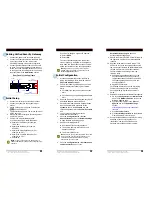
SS-16 VoIP-2-GSM USER MANUAL
DOC. NO: SS-16-14 (REV. 02)
Page 78 of 84
8.
GLOSSARY
3G
– “Third generation” mobile networks, specially designed for high speed data
services. The classic definition of wireless networks that following the 2G systems
(GSM) and they offer high speed data services in addition to the basic voice
capability. These 3G mobile communications systems provide an enhanced range of
multimedia services (high speed Internet access, video streaming, etc.). The high
data transfer speed specific to the third generation communications network leads to
an increased efficiency of information transmission, while the real time access to data
and information means important savings of time and money. UMTS is the best
known of the 3Gnetworks, while HSDPA is a 3,5G development.
ANI
– Acronym for
Automatic Number Identification
- a feature of telephony
intelligent network services which allows subscribers to display or capture the
telephone numbers of calling parties. The service is often provided by sending the
digital tone multi frequency (DTMF) tones along with the call. Home users of ANI can
screen callers. ANI is commonly used by emergency centre dispatchers to save the
caller having to report the information and, when necessary, to help locate callers. A
telephone company's 9-1-1 service to a public safety point usually includes the ANI
feature. For instance, in a call center, ANI displays the number of the calling party to
the call center agent in real time. Among other things, the call center can use the
information to forward calls to different people for different geographic areas.
DHCP
(Dynamic Host Configuration Protocol) - This protocol allows a computer (or
many computers on your network) to be automatically assigned a single IP address
from a DHCP server. DHCP is available on SS-16 VOIP-2-GSM number that the
caller dialled. DNIS works by passing the touch tone digits (dual tone multi frequency
or MF digits) to the destination where a special facility can read and display them or
make them available for call center programming. For example, a company may have
a different toll free number for each product line it sells. If a call center is handling
calls for multiple product lines, the switch that receives the call can examine the
DNIS, and then play the appropriate recorded greeting. Another example of multiple
toll free numbers might be used for multi-lingual identification. A dedicated toll free
number might be set up for Spanish or Chinese speaking customers.
DNS
– Acronym for Domain Name System (or Service), an Internet service that
translates domain names into IP addresses. This allows the Internet hosts to use both
addresses type domain name (such as SS Telecoms.ro or linux.org), and addresses
type IP numbers (for instance 192.17.3.4). The domain name addresses are intended
for human users and are automatically converted into IP (numeric) addresses.
Because domain names are alphabetic, they are much easier to remember. The
Internet however, is really based on IP addresses. Every time you use a domain
name, therefore, a DNS service must translate the name into the corresponding IP
address.
DNS Server
– computer able to answer to the interrogations in a DNS system. The
DNS server maintains a database that includes the host computers with their domain
names and the corresponding IP addresses. For instance, if you ask the DNS server
for the domain name apex.com, it will return the IP address of the hypothetical
company called Apex. DNS servers are linked in their network, so if one DNS server
doesn't know how to translate a particular domain name, it asks another one, and so
on, until the correct IP address is found. When a user enters a domain name into the
Internet browser, the user is sent by the DNS Server to the proper IP address. The
DNS server address used by the computers on your home network is the location of
the DNS
DNS Server Address
(Domain Name System) - DNS allows Internet host computers
to have a domain name and one or more IP addresses. A DNS server keeps a
database of host computers and their respective domain names and IP addresses, so
that server your ISP has assigned.







































